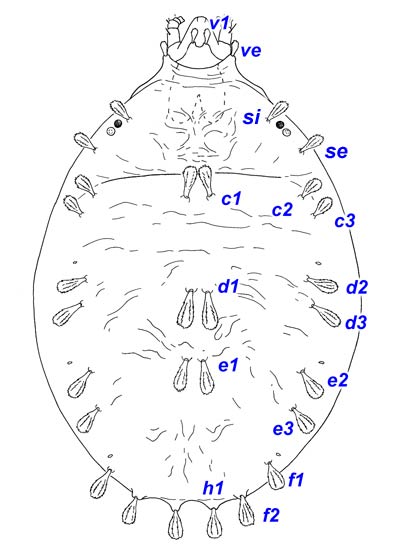Bryobia
Superfamily Tetranychoidea
Family Tetranychidae
Subfamily Bryobiinae
Tribe Bryobiini
Genus Bryobia
Common names: clover mites, brown mites
Probability of Encounter: High
Quarantine importance: High. The genus Bryobia contains a number of economically important pests, including several that are not yet reported from the USA. Most of the economically important species are highly polyphagous and thelytokous (i.e. without males). Some well known and widely distributed pests include the brown clover mite Bryobia praetiosa (Koch), a pest of over 250 kinds of plants. Most of the important pests are similar to B. praetiosa in appearance and difficult to distinguish. Some of current quarantine interest include:
-
Bryobia graminum (Schrank) is an important pest of apple, pear, citrus, cole crops, clover and grasses in many European countries including the United Kingdom, North Africa, Asia including Japan, Chile, Australia, and New Zealand.

-
Bryobia kissophila Van Eyndhoven, the ivy mite, attacks potato and ivy and can be a pest in greenhouses on ivy. It is currently known from Europe, Costa Rica, Chile, New Zealand, and parts of Australia.
-
Bryobia lagodechiana Reck is a pest of beans, cucumber, currants, eggplant, grasses, clover and some flowers in Europe, Japan, New Zealand, and Canada. It can be a pest in greenhouses.
-
Bryobia vasiljevi Reck is a pest of apple, passion fruit, asparagus, wheat and other grasses, and some flowers in Europe, Australia, and New Zealand.
Diagnosis:
-
Dorsally flattened mites with red cuticle; dark body contents; short, flattened, white setae; and very long legs I.
-
Claws hooked; empodium pad-like and with more than 1 pair of tenent hairs.
-
Prodorsum with 4 pairs of setae (vi, ve, sci, sce), vi and ve borne on prominent lobes over gnathosoma.
-
Adult female with 3 pairs of anal setae (ps1-3) and 2 pairs of paranal setae (h2-3).
-
Opisthosoma with 12 pairs of setae (c1-3, d1-3, e1-3, f1-2, h1, typically club-shaped.
Similar taxa. The true spider mites (e.g. species of Eutetranychus) in the Tetranychinae do not have empodia with tenent hairs. The claws are pad-like in other tribes of Bryobiinae.
References
Baker EW & AE Pritchard. 1960. The tetranychoid mites of Africa. Hilgardia 29(11): 455-574.
Baker EW & DM Tuttle. 1994. A guide to the spider mites (Tetranychidae) of the United States. Indira Pub. House, West Bloomfield, MI: 347 pp.
Bolland HR, J Gutierre & CHW Flechtmann. 1998. World Catalogue of the Spider Mite Family (Acari: Tetranychidae). Brill: Leiden.
Helle W & MW Sabelis (eds.) 1985. Spider Mites, Their Biology, Natural Enemies, and Control, vol. 1A. Elsevier: New York.
Jeppson LR, HH Keifer & EW Baker. 1975. Mites Injurious to Economic Plants, University of California Press: Berkeley
Manson DCM. 1967. The spider mite family Tetranychidae in New Zealand I. the genus Bryobia. Acarologia 9: 76-123.
Meyer, M.K.P. 1974. A revision of the Tetranychidae of Africa (Acari) with a key to the genera of the world. Dept. Agr. Tech. Serv. Mem. 36: 291 pp.
Meyer, M.K.P. Smith 1987. African Tetranychidae (Acari: Prostigmata) - with reference to the world genera. S. Afr. Dept. Agr. Water Supply, Entomol. Mem. No. 69: 175 pp.
Morgan CVG. 1960a. Notes on the occurrence and morphology of Bryobia lagodechiana Reck in British Columbia (Acarina:Tetranychidae). Can. Entomol. 92: 634-636.
Morgan CVG. 1960b. Anatomical characters distinguishing Bryobia arborea M. and A. and B. praetiosa Koch (Acarina:Tetranychidae) from various areas of the world. Can. Entomol. 92: 595-604
Zhang Z-Q. 2003. Mites of greenhouses: identification, biology and control. CABI Publishing, Wallingford: 244 pp.